Nanoscale IR Spectroscopy: AFM-IR — A New Technique
By combining atomic force microscopy (AFM) and infrared (IR) spectroscopy, one can attain spatial resolution improvements of two orders of magnitude over traditional IR spectroscopy.
The combination of atomic force microscopy (AFM) and infrared (IR) spectroscopy in the technique of AFM-IR is one of the most important recent developments in the field of IR microspectroscopy and chemical imaging. The importance of IR spectroscopy to our scientific infrastructure needs no introduction given the size of the industry and the breadth of its application. However, the fundamental physical limit imposed by diffraction has prevented the use of this technique in applications requiring high spatial resolution, which is the case for many applications in polymers and the life sciences. AFM-IR uses an AFM probe as the IR absorbance sensor and hence breaks through the diffraction limit to attain spatial resolution improvements of up to two orders of magnitude over traditional IR microspectroscopy.
Infrared (IR) spectroscopy is one of the most practiced analytical measurement techniques in industrial and academic R&D laboratories. Unfortunately, diffraction physics limit its spatial resolution to ~5 µm. A spatial resolution breakthrough has been achieved with a novel technique that uses a nanoscale probe from an atomic force microscope acting as the IR absorbance detector (1). The nature of the IR absorbance detection results in simultaneous measurements of nanoscale mechanical properties and nanoscale morphology, along with the chemical composition. The technique also integrates nanoscale thermal property mapping, resulting in a multifunctional tool that provides nanoscale structure, chemical, mechanical, and thermal properties.
Introduction to AFM-IR
Atomic force microscopy with infrared spectroscopy (AFM-IR) is based on photothermal induced resonance (PTIR), a technique that was pioneered by Alexandre Dazzi from the Laboratoire de Chimie Physique, CLIO, at the Université Paris-Sud in Orsay, France (2–6).
The AFM-IR technique uses a pulsed, tunable IR source to excite molecular vibrations in a sample that has been mounted on an IR-transparent prism. This creates an illumination configuration similar to conventional attenuated-total-reflection (ATR) spectroscopy. As the sample absorbs radiation, it heats up, leading to rapid thermal expansion that excites resonant oscillations of the cantilever. The induced oscillations decay in a characteristic ringdown, as shown in Figure 1.
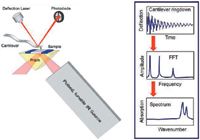
Figure 1
The ringdown can be analyzed with Fourier techniques to extract the amplitudes and frequencies of the oscillations. Measuring the amplitudes of the cantilever oscillation as a function of the source wavelength creates local absorption spectra; the oscillation frequencies of the ringdown are related to the mechanical stiffness of the sample.
Users of AFM-IR can quickly survey regions of a sample with AFM imaging and then rapidly acquire high-resolution chemical spectra at selected regions on the sample. As shown in Figure 2, polymer spectra acquired with AFM-IR have demonstrated good correlation with bulk Fourier-transform infrared (FT-IR) spectra.
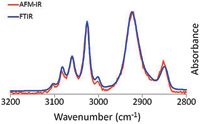
Figure 2
This capability allows researchers to import individual nanoscale IR spectra into commercial IR databases where they can digitally search to chemically identify the materials at the specific sample locations measured. Alternatively, the IR source can be tuned to a single wavelength to map compositional variations across the sample surface.
In addition to its ability to provide high-resolution infrared spectra, the technique provides information on the mechanical properties of the sample. This is accomplished, as mentioned above, by monitoring the frequency of the fundamental or higher resonant modes of the cantilever. This is analogous to the contact resonance method used for a number of years in the AFM community. The contact resonant frequency of the cantilever in the AFM-IR system correlates to the stiffness of the sample and can be used to map the modulus of the sample qualitatively. It also can perform nanoscale thermal analysis utilizing novel AFM cantilevers that incorporate a resistive heating element into the end of the cantilever. Using these cantilevers in combination with the system allows for the local measurement of the transition temperature of materials to a single point or an array of points across a sample. This can then identify or map the amorphous or crystalline content, stress, extent of cure, or other material properties which can be characterized by the transition temperature of the material.
This combination of measurement capabilities creates a multifunctional tool that provides nanoscale structure, chemical, mechanical, and thermal properties.
Experimental
The IR source in the AFM-IR system used in this study (nanoIR, Anasys Instruments, Santa Barbara, California) is a pulsed laser that is continuously tunable from 1200 to 3600 cm-1. All AFM topographic images are obtained in contact mode with either an AppNano SICONA 450 µm (Santa Clara, California), Team-Nanotec Improved Super Cone 450 µm (Villingen-Schwenningen, Germany) contact mode cantilevers, or ThermaLever self-heating cantilevers (Anasys Instruments). The spatial resolution of the IR spectra measured is determined by the AFM tip size, but it can deteriorate from this ideal for thicker samples because of heat transfer from regions deeper in the sample to the point at the sample surface where the AFM tip detects the signal. In the studies discussed in this article, sample thicknesses are typically 300–500 nm and we estimate the spatial resolution of the IR spectra to be about 100 nm.
Measurements of Polymeric Samples
AFM-IR is ideal for measuring polymeric samples in which there are local material variations (7). This includes materials such as polymer blends, multilayer films, nanocomposites, and micro- and nanoscale defects in materials. A number of examples follow that demonstrate the utility of the technique in these application areas.
AFM-IR requires a thin film sample that is deposited on the prism surface. To accomplish this, the typical sample preparation technique is to use ultramicrotomy to cut sections with thicknesses between 100 nm and 1000 nm. The sections are then transferred to a prism surface. Alternatively, the sample can be deposited out of solution, either drop cast or spin coated, onto the prism surface. Regardless of the sample preparation method, it is important that good optical contact be made between the sample and the prism surface to obtain the highest-quality spectral results.
Multilayer Films
A multilayer film example is shown in Figure 3 and demonstrates the multifunctional measurement capability of AFM-IR. This particular film has a number of layers with the central layer being nylon surrounded by two ethylene acrylic acetate (EAA) layers. Figure 3a shows the topographic image of the surface of the sample, which was created by embedding and microtoming the film.
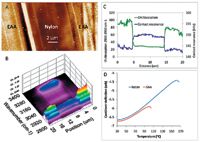
Figure 3
After visualizing the different layers of the film in the topography, an array of spectra was collected across the sample surface, as shown in figure 3b. These spectra were collected over the range of 2800–3400 cm-1 , which includes the CH- and NH-stretching absorption bands. The two materials are clearly differentiated by their differing absorption in these two bands with a resolution of ~100 nm. The mechanical and spectroscopic data were obtained simultaneously, thus allowing direct correlation of mechanical stiffness information with chemical composition data (see Figure 3c). Note that the transitions in contact stiffness correlate extremely well with the strength of the CH absorption. The nanothermal analysis also was performed on the same sample, clearly identifying softening at different temperatures for the nylon and EAA layers (see Figure 3d).
Polymer Blends
Within polymer blends, one of the challenges is in characterizing the extent of miscibility of the components and identifying the size and distribution of domains in immiscible or partially miscible blends.
Various techniques are used to image and characterize these domains, including electron microscopy, Raman microscopy, and AFM. AFM-IR brings the advantages of multiple property evaluation and the rich IR spectral information. An example of using the chemical identification capability of AFM-IR to identify domains in a blend is shown in Figure 4. The sample is a polycarbonate-poly(methyl methacrylate) (PC-PMMA) blend, which shows domain structure at the micrometer and submicrometer scale. The two components can be differentiated by the structure of the domains seen in the AFM image with one material exhibiting smooth domains after being microtomed and the other showing a rougher surface. These domains can then be identified as either PC or PMMA by the strength of the characteristic PC absorptions at 1770 and 1496 cm-1. Six spectra were taken across an interface between the two components with a separation of 100 nm. The PMMA dominates in spectra 1–3, while spectra 4–6 show a higher PC composition.
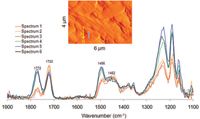
Figure 4
Polystyrene–Epoxy Composite
Figure 5 shows an AFM image with spatially resolved IR absorption spectra recorded on a thin section of a model composite of polystyrene (PS) and epoxy. The sharp transition in the spectral characteristics on either side of the PS-epoxy boundary demonstrates spatial resolution well beyond conventional IR microspectroscopy. Note that the IR spectrum collected at the center of the PS circular domain is an excellent match with the spectra recorded with 100 nm of the PS-epoxy boundary. Spectra on the lower left and right of Figure 5 collected between 2500 cm-1 and 3700 cm-1 within 100 nm of the PS-epoxy boundary show little or no evidence of the polystyrene aromatic CH-stretching absorption bands above 3000 cm-1.
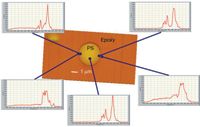
Figure 5
Degradable Polymers
Biodegradable polymers are important materials in a variety of applications ranging from tissue engineering, drug delivery, food packaging, and textiles. Such materials are increasingly complex blends of base materials and performance enhancing additives. The AFM-IR technique has been used to map, characterize, and even identify specific polymer additives. The AFM measurements allow mapping of the structure of the polymer matrix and additives. AFM-IR can then be used to spatially map variations in chemical components. In the line spectral map (Figure 6, right side), note the spatially varying intensities of the C=O carbonyl band (1740 cm-1 ) and the single bond C-O peak around 1100 cm-1. These variations indicate the location of the two components in this material.
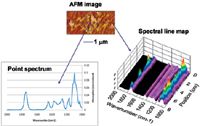
Figure 6: Spectral mapping of a degradable polymer blend.
Summary
AFM-IR enables IR spectroscopy with 100-nm spatial resolution using AFM. It also provides high resolution topographic, chemical, mechanical, and thermal mapping. These measurements have been illustrated here using applications in polymer blends and multilayer films. Other publications have demonstrated the technique's capability with a broad range of materials and applications, including subcellular spectroscopy (8–11).
Kevin Kjoller, Mike Lo, Craig Prater, and Roshan Shetty are with Anasys Instruments in Santa Barbara, California.
Alexandre Dazzi is with the University of Paris-Sud in Orsay, France and is a scientific advisor with Anasys Instruments.
Curtis Marcott is a senior partner at Light Light Solutions (a consultancy firm specializing in vibrational spectroscopy) in Athens, Georgia, and a former research fellow at Proctor & Gamble. He has 35 years of experience in the IR spectroscopy field (including more than 100 publications). He received the Williams-Wright Award from the Coblentz Society in 1993 and was the 2011 President of the Society for Applied Spectroscopy. Please direct correspondence to: marcott@lightlightsolutions.com.
References
(1) K. Kjoller, J. Felts, D. Cook, C. Prater, and W. King, Nanotechnol. 21, 185705 (2010).
(2) A .Dazzi, R.P.F. Glotin, and J.M. Ortega, Infrar. Phys. and Technol. 49, 113–121 (2006).
(3) A. Dazzi, in Biomedical Vibrational Spectroscopy, P. Lasch and J. Kneipp, Eds. (J. Wiley & Sons, Hoboken, New Jersey, 2008), Chapter 13.
(4) J. Houel, E. Homeyer, S. Sauvage, P. Boucaud, and A. Dazzi, Opt. Exp. 17, 10887–10894 (2009).
(5) A. Dazzi, Thermal Nanosystems and Nanomaterials, S. Volz, Ed. (Springer Berlin/Heidelberg, 2009), Chapter 16, pp. 469–503.
(6) A. Dazzi, F. Glotin, and R. Carminati, J. Appl. Phys. 107, 124519 (2010).
(7) CC. Prater et al., Microscop. & Anal. (SPM) 24, 5–8 (2010).
(8) A. Dazzi et al., Ultramicroscopy 108, 635–641 (2008).
(9) A. Dazzi et al., Optics Lett. 33, 1611–1613 (2008).
(10) C. Mayet, A. Dazzi, R. Prazeres, J.M. Ortega, and D. Jaillard, Analyst 135, 2540–2545 (2010).
(11) C. Policar et al., Angewandte Chemie Internat.Ed. 50, 860–864 (2011).
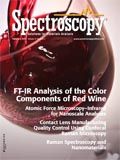
AI Shakes Up Spectroscopy as New Tools Reveal the Secret Life of Molecules
April 14th 2025A leading-edge review led by researchers at Oak Ridge National Laboratory and MIT explores how artificial intelligence is revolutionizing the study of molecular vibrations and phonon dynamics. From infrared and Raman spectroscopy to neutron and X-ray scattering, AI is transforming how scientists interpret vibrational spectra and predict material behaviors.
Real-Time Battery Health Tracking Using Fiber-Optic Sensors
April 9th 2025A new study by researchers from Palo Alto Research Center (PARC, a Xerox Company) and LG Chem Power presents a novel method for real-time battery monitoring using embedded fiber-optic sensors. This approach enhances state-of-charge (SOC) and state-of-health (SOH) estimations, potentially improving the efficiency and lifespan of lithium-ion batteries in electric vehicles (xEVs).
New Study Provides Insights into Chiral Smectic Phases
March 31st 2025Researchers from the Institute of Nuclear Physics Polish Academy of Sciences have unveiled new insights into the molecular arrangement of the 7HH6 compound’s smectic phases using X-ray diffraction (XRD) and infrared (IR) spectroscopy.